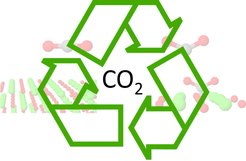Turning Greenhouse Gases into Useful Chemicals
CO2 is a critical pollutant of the atmosphere with noticeable climatic consequences. However, routes already exist to convert CO2 into useful chemicals or fuels. The key is catalysis – a process of accelerating desired chemical reactions, involving special materials (catalysts).

But the known catalysts are too inefficient for making this conversion practicable. An important step is the identification of materials that “activate” CO2, i.e., make the molecule ready for a chemical reaction. Using high-throughput calculations and subgroup discovery, scientists at the NOMAD Laboratory identified the materials properties (genes) and rules that classify potentially good catalytic materials for the desired purpose.
Because of its chemical stability, CO2 is presently one of the critical mankind-created greenhouses gases. However, at some point CO2 may well become a raw material for creating fuels and valuable chemicals. The catalytic, chemical conversion towards methane (viable for combustion engines and heating) and other important chemicals is all possible, already today, but the process is very inefficient. We need better catalysts.
The NOMAD Laboratory developed and advanced artificial intelligence (AI) methods that enable the identification of basic materials parameters that correlate with materials properties and functions of interest (here the activation of CO2). These parameters are also called materials genes as they correlate with different mechanisms that trigger, but maybe just facilitate or even hinder the different processes playing together, depending on their combination – very much as genes in biology. In the coordinate system of these genes, regions are identified where good catalytic materials can be found. Specifically, this CO2 study employed the AI method called “subgroup discovery”, and it focused on the wide class of metal oxides.
Catalysis happens at surfaces. Thus, the study also considered various surfaces of all these materials. Altogether, 141 different surfaces where calculated (71 different materials) with state-of-the-art density-functional-theory high-throughput methodology. The results were then used for training the AI.
In general terms, this study also represents a conceptual change of modeling heterogeneous catalysis (and other materials functions). In the past it was attempted to calculate the full catalytic process. However, it became clear that the many aspects that rule heterogeneous catalysis, e.g. the dynamical restructuring of the surface under reaction conditions, are too intricate, and that a full theoretical description does not make sense. Thus, a combined approach linking high-throughput calculations, AI, and experimental results appears more appropriate and was suggested in this study.
